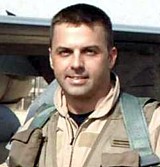Troy Gilbert presumed dead in F-16 crash
 Maj. Troy L. Gilbert, whose F-16GC Fighting Falcon crashed Monday in Iraq, was described as a husband and father of five who always did what it took to get the mission done.
Maj. Troy L. Gilbert, whose F-16GC Fighting Falcon crashed Monday in Iraq, was described as a husband and father of five who always did what it took to get the mission done.Four days after the crash, Gilbert, 34, was still officially considered missing, although the Air Force retrieved human remains from the crash site, according to a Central Air Forces statement. The service was waiting on DNA testing to identify the remains.
“Troy was first and foremost a wonderful husband and father,” a statement from his family said. “His Christian faith, personal values, and work ethic guided his personal life and his career as a military officer.
“He was highly respected by and deeply loved by so many. At the time of the tragedy during combat operations, he was unselfishly protecting the lives of other American military members. We, his family, cherish the worldwide prayers and support during this extremely difficult time.”
Gilbert was flying a close-air support mission backing up ground troops in Anbar province, the area of Iraq where many of the country’s Sunni insurgent groups operate, when his jet crashed. Air Force officials haven’t said why the plane crashed, although they said there was no evidence it had been shot down.
Iraqi insurgents claimed a shoulder-fired, anti-aircraft missile downed the jet.
Insurgents reached Gilbert before the U.S. military quick-reaction team did. Videotape pictures obtained by Associated Press Television News appear to show the wreckage of the F-16 in the farm field where it crashed and the nearby remains of a U.S. serviceman with a tangled parachute.
At the time of the crash, Gilbert was deployed to the 332nd Expeditionary Wing at Balad Air Force Base in Iraq. He had arrived there in September from his assignment at Luke Air Force Base, Ariz., where he was an instructor pilot and deputy director of operations for the 309th Fighter Squadron.
Gilbert was commissioned in 1994 after earning a bachelor’s degree in economics from Texas Tech University. After two tours as a protocol officer, he entered the pilot training program and graduated from the F-16 course in 2001. He served at the 555th Fighter Squadron, Aviano Air Base, Italy, until being assigned to Luke in 2003.
From the Air Force Times

<< Home